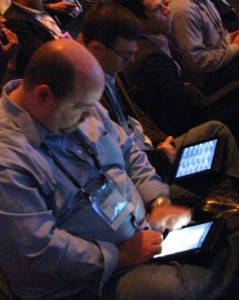 I tend to be a skeptic about new technology, probably a consequence of 25 years of seeing cool demos of products that never worked very well in real life. I tend to be a late adopter, too. I only got on the smart phone bandwagon a year ago after Apple had already shipped 100 million of them. I was also blasé about the iPad when it was announced in January. In my only tweet on the subject, I called it a “big iPhone.”
I tend to be a skeptic about new technology, probably a consequence of 25 years of seeing cool demos of products that never worked very well in real life. I tend to be a late adopter, too. I only got on the smart phone bandwagon a year ago after Apple had already shipped 100 million of them. I was also blasé about the iPad when it was announced in January. In my only tweet on the subject, I called it a “big iPhone.”
But after spending three days at a conference in San Francisco this week watching and talking to iPad users, I’m now convinced that tablets will all but displace laptops within the next few years. In short, tablets are built for what people want to do with a portable device, while laptops are essentially scaled-down desktop PCs. We’ve carried them for 20 years because they were what we thought portable computers should be. Now we know better.
By “tablet,” I don’t mean “iPad.” Samsung just released the first Android tablet and we can expect many more to follow. We can also expect special-purpose devices like the Amazon Kindle to become more feature-rich over time. The difference between these devices and PCs is that they are designed specifically with the needs of the mobile user in mind. Laptops and the early versions of Windows tablets (the machines have been around for a decade), never were.
Travel-Ready
As I sat in the outlet-deprived seats at the Web 2.0 Summit this week, I scanned the rows of iPad owners with envy. My Toshiba laptop gets less than two hours of battery life on its stingiest setting. It takes three minutes to start and its eight-pound mass is awkward, hot and uncomfortable.
In contrast, the iPad’s battery life is conservatively rated at 10 hours. It starts in seconds and can easily be held with one hand or cradled in the nook of your arm. Apps start and switched quickly. It can be flipped vertically for book reading or horizontally for Web browsing. People say reading books and periodicals with Kindle and Nook apps on the iPad is nearly as good as reading on a Kindle or a Nook.
There has been no innovation in laptops in more than a decade. Hardware makers have mainly crammed their devices full of storage and memory to the point of excess. My laptop has 300GB of disk storage. What the heck am I going to do with that?
Tablets use fast, lightweight flash storage, which is why they start so quickly. Sure, there’s a lot less capacity, but how much do you really need for a couple of days on the road? I don’t have to carry all nine seasons of “24” in my briefcase.
The primary advantage laptops is the keyboard, and even iPad fanatics will tell you that typing on a screen is neither as fast nor as tactile as using a keyboard. However, external wireless keyboards and voice recognition will quickly resolve tablets’ shortcomings in these areas.
A decade from now, a new generation of youngsters will think it funny to hear daddy tell about how he used to skulk around airports looking for power outlets. We’ll probably think it’s pretty funny, too.
Oppenheimer & Co. forecast this week that shipments of tablets will soar grow from 15 million units this year to more than 115 million in 2014. Oppenheimer knows what I learned in San Francisco this week. The laptop has had a long a fruitful run, but it’s time for that 1980s technology to wind down. There’s a new king in town.
